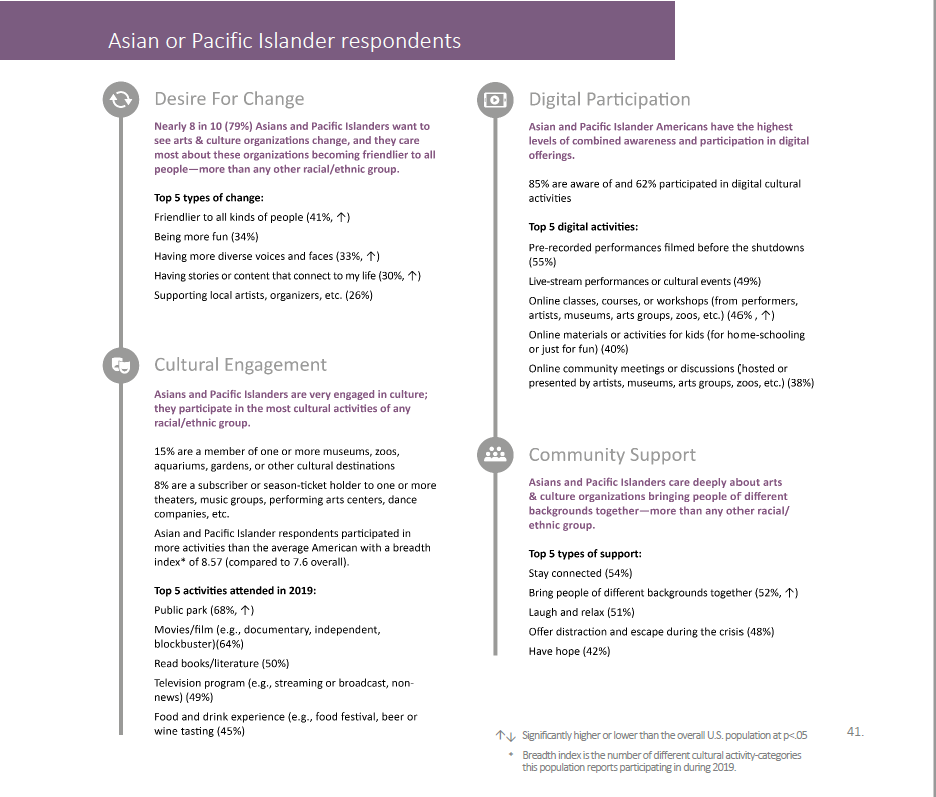In mid-December 2020, LaPlaca Cohen and Slover Linett Audience Research released an analysis of the data they collected in the Covid edition of the CultureTrack survey through the lens of race and ethnicity.
The three broad categories of change the survey results indicated are:
• Becoming more inclusive and community-centered is the most widely desired category and includes greater diversity of voices and faces, greater focus on localness (local artists, local nonprofits, and the local community), more engagement with young people, treating employees fairly, and being friendlier to all kinds of people. More than half (55%) of Americans overall want one or more of those changes, and that desire is even higher for BIPOC groups (63%–76% across categories).
• Becoming more casual and enjoyable includes changes toward fun, informality, and child friendliness, and is desired by more than a third of Americans overall (41%) and fully half of Hispanic/Latinx Americans (51%).
• More reflective and dynamic content includes “stories or content that connect to my life” and “more frequent new works or exhibits.” Over a quarter of Americans (29%) want one or both of these changes, and this desire is strongest among Asian and Pacific Islanders (43%).
There was already an acknowledgment that these were needs that needed to be addressed prior to Covid so there are not surprises here. While the researchers note the CultureTrack survey ended just days before George Floyd was killed, my sense is that is if there has been any change, it is likely in the direction of these sentiments deepening.
Also perhaps not surprising was the finding that the people with an existing affiliation to a cultural organization are least likely to want things to change. “Asian/Pacific Islander, Black/African American, and Hispanic/Latinx — were more likely to hope change occurs than the overall population.” However, income level played an interesting role: “For Asians or Pacific Islanders, Black/African Americans, and multiracial Americans, desire for change is stronger among those with higher incomes; for White or Caucasian Americans, desire for change is stronger among those with lower incomes.” (My bold, their italics)
One thing to note before we look at the other results: The survey used very broad definitions of what constituted culture in their survey. Keep in mind that when people say they value an experience, it may not necessarily be the type offered by a formal, bricks and mortar entity or they may not be having the experiences with those entities.
For example, the survey results notes:
Blacks/African Americans are more likely than other groups to say that arts and culture organizations can help their communities stay informed with trusted information. This was the most-selected response to that question for Blacks/African Americans, and it was not even in the top three among other racial/ethnic groups….
Together, these disproportionate impacts, unique needs, and personal creativity may suggest ways that arts and culture organizations and funders could rethink programming and relevance to better serve BIPOC Americans.
There are greater specifics on page 21 of the PDF copy of the report:
This greater emphasis placed by some BIPOC Americans on the social, civic, emotional, therapeutic, and creative-expression roles of cultural participation may help practitioners and funders think more broadly about service and relevance to communities of color during difficult times.
The authors go on to note that “digital only” audiences are much more diverse than traditional in-person ones. (Though that may have changed since the survey was conducted in the early days of Covid and digital offerings began to include a price tag.) Acknowledging that much more study is required, they mention some of the questions they want to answer in the next iteration of the survey (my emphasis):
To the extent that this may be due to lower financial and logistical barriers in the online realm, it raises questions for funders and practitioners about how to preserve accessibility and inclusion as cultural organizations shift from free to paid or subscription models for their digital offerings. To the extent that it may be due to the absence of some of the social or cultural doubts and discomforts associated with in-person attendance for some Americans (Will there be people who look like me? Will the norms of participation be congenial for me? Will I feel safe?), then the question is what might we learn from online cultural experiences about how to make in-person experiences more accessible, especially for BIPOC Americans?
To a great extent, nearly every data point that emerged lead the researchers to more “Why is that?” questions. They seemed a bit flummoxed by results that showed Native Americans are more likely than the general US population (50% vs. 19%) to have practiced photography or photo editing. The questions they pose can be valuable for local conversations with different groups.
Starting at page 46 of the PDF, there are snapshot summaries of the results from different ethnic groups like this one you can peruse.
